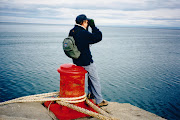
In The Ramble in Central Park, Dick and Allen sit on a bench in front of a birdwatching area strung, like an avian Cirque du Soleil, with suspended Clorox containers and white athletic socks stuffed with seed. Sparrows, mostly, they say when I stop to ask what they're viewing. It's still early on, only two weeks into the season. But the Park, Dick explains to me casually, one leg folded over the other, is one of the best places to watch and wait, thanks to the migration. Dapper and obviously well-settled in the world, old men now, Dick and Allen have been watching birds together since the 1940's, when they were ten years old. They still make time to sit together, they tell me, both in the city and at their homes upstate and in the Colorado mountains. Today they sit at their ease in The Ramble, while a fat squirrel disappears into a Clorox bottle. At various moments they direct a young photographer they've hired, who's balancing on a ladder and behind a huge lens, to catch this bird or that one. They don't answer when I ask if there is something they have wanted to see all their lives, but haven't seen. Dick jokes only that Allen is old enough to have seen a Dodo.
The same day, in the Park, near the Museum of Natural History, I meet a dogwalker who doesn't offer his name, but who does tell me the name of the dog at the end of his leash: Penelope. Penelope is a lovely fawn and white pit bull. I can't remember ever thinking of a pit bull as being lovely. But she is. I learn that Penelope is up for adoption from a local group called
Stray From the Heart. The dogwalker works for her foster family, and for others, walking up to twelve dogs a day--although he was, he nods toward me with a strange, unstable roll in his eyes, once upon a time a professional trumpet player, trained at Julliard and a regular performer at Radio City Music Hall. Pit bulls, he tells me, are not mad dogs. They're made that way. Most of those he walked came from the Bronx, where in addition to being fought they were strung up by their paws and beaten, to make them mean. With the economy being so bad, more strays were coming in than ever before; even sweet, tender things like Penelope, who had never been abused, but still, because she looked like a pit bull, would be hard to place. All that could be hoped, he told me before we parted ways at the next corner, was that the family who had her now would decide she was good enough to keep. And he hurried away in his dusty black coat and loose sneakers, Penelope close at his heels.
--MD
Photo by
Bruce Barone














